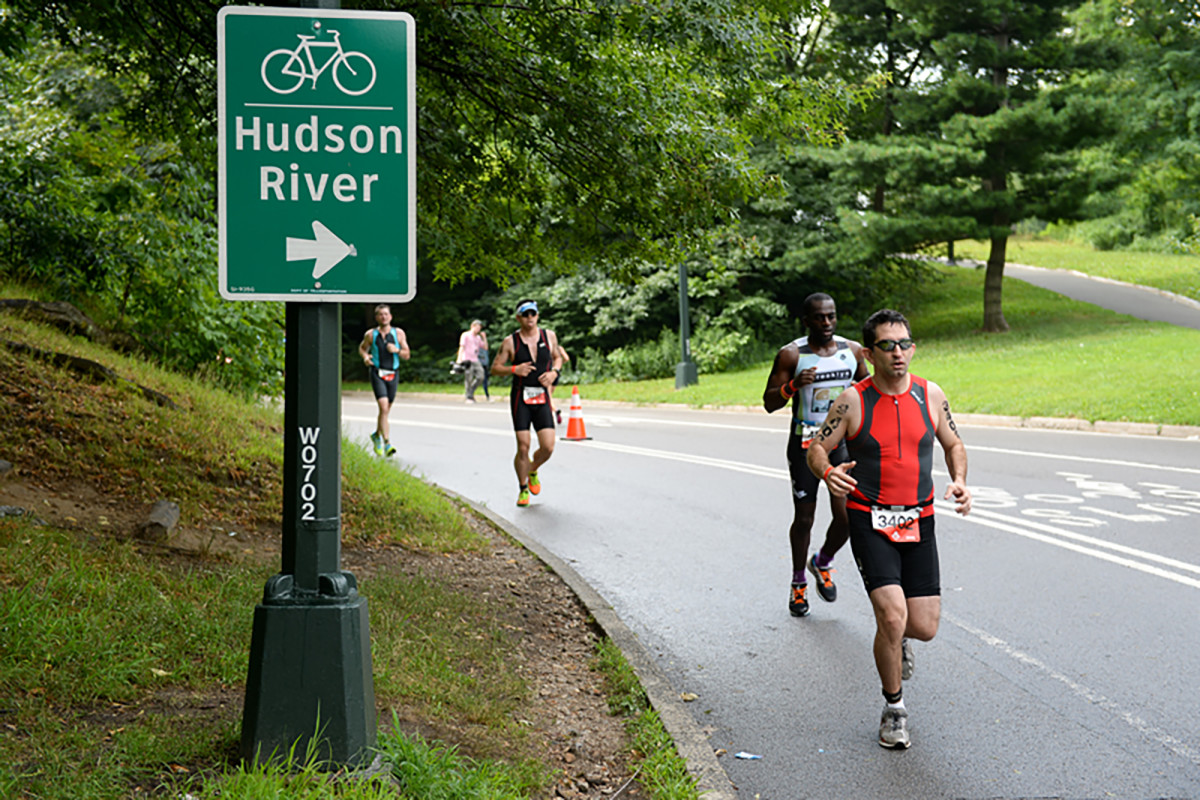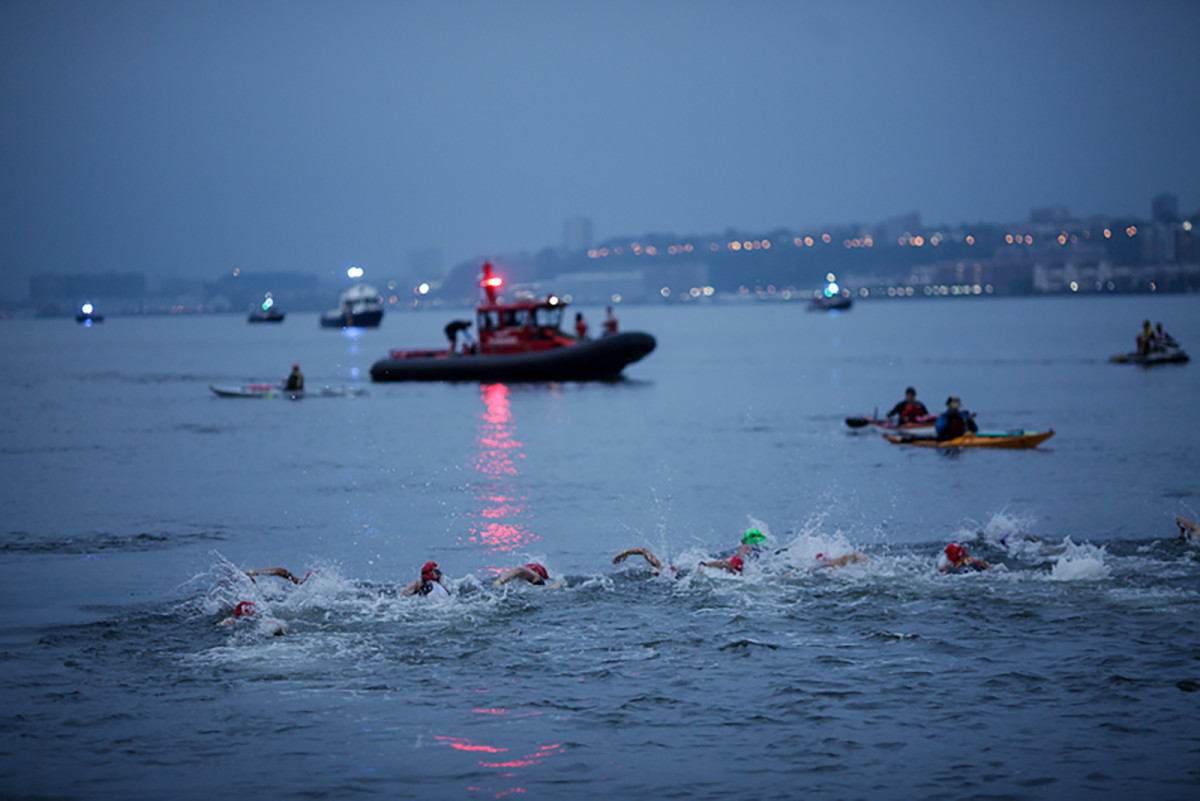Taking on the triathlon: A first-timer's quest to complete the swim, bike, run

For much of the last six years, running has been my main form of exercise. But after three marathons, 12 half marathons and far too many shorter-distance races to count, going out for a run each day was beginning to feel less like a privilege and more like a chore.
Enter: triathlon. More specifically, the NYC Triathlon.

Swimming 1500 meters, biking 40 kilometers and running 10 kilometers doesn’t feel intimidating...as separate events, of course. But all together, back to back? Now that’s a new challenge, to say the least. Plus, aren’t triathletes required to train every waking hour of the day when they’re not working or eating?
But there’s something about rediscovering an old sport (I swam competitively in high school) and learning a new one (until a few weeks ago, the only biking that I did was on New York’s Citibikes) that I couldn’t pass up. So I’m diving in headfirst. But that’s not to say this adventure doesn’t come with more than a few challenges. So I sought out help from an expert: Alex Isaly, a lead trainer at LifeTime fitness and a triathlon coach, has completed many triathlons in his day. He walked me through everything a newbie triathlete should know before attempting an Olympic-distance race, from the basics of what I needed to exactly how I should be training.
The Gear
Race day outfits are always a big deal for athletes to plan, but when the event requires three different sports? Yeah, it can get challenging. Often, when you think of a triathlete, you picture somebody swimming and running in a bathing suit, which is usually what you see at the Olympics. But for the average person training and competing in age-group triathlon races, there’s often much more gear involved.
Let’s start with the swim. Getting a swimsuit, cap and goggles for the pool workouts wasn’t a big deal, thanks to my competitive swimming days.
But for many age-group level triathlons, athletes don’t wear swimsuits for the swim portion. The base of many triathletes’ race-day gear is a tri suit (one-piece) or a tri kit (two-piece), a quick-dry top and lightly-padded shorts designed to be worn for every leg of the event—even under the wetsuit on the swim. I’m still searching for the perfect tri kit, so I’ll let you know how that turns out.
The best sport swimsuits for laps, surfing, snorkeling and more
Many triathlons are “wetsuit legal,” meaning athletes are allowed to wear wetsuits if the temperature of the water is 78.0 degrees or lower. (Athletes can also wear a wetsuit if the water is between 78.1 and 84.0 degrees, but they will not be eligible for prizes.) The water temperature of the Hudson River, where the swim leg of the NYC Tri takes place, hovers in the 70s, so a wetsuit will be necessary for this race. Since I’m not quite ready to foot the bill for a wetsuit, I’ll be renting one for the race.
On to the bike. I needed a bike suitable for racing 40 kilometers, but again, in the name of being cost-effective, I didn’t want to drop a ton of money on a bike. I explained my dilemma to my local bike shop, and after sizing me for a bike—a small or medium bike frame, with a top tube between 51 and 54 cm—they directed me to Craigslist. Luckily, I stumbled on a reasonably priced road bike that closely matched my requirements—and in my neighborhood, no less! One tuneup and helmet purchase later, I was ready to hit the roads.
Well, almost. After no fewer than two rides wearing just spandex crops, I quickly realized that I needed padded bike shorts. Thanks to a friend’s recommendation, a pair arrived on my doorstep two days later—thank you, Amazon Prime!
Isaly highly recommends a few extra items to increase comfort level on race day, including sunglasses, a hat (for the run), a number belt with a pocket for nutrition, water bottles for hydration on the bike and run, and a watch, to name a few. Luckily, I already have all of those things from marathon training last fall.
So, I have the swimsuit, cap and goggles (and a rented wetsuit on the way); the bike, helmet and padded shorts; and plenty of running gear. That’s all I need to get to the finish line, right? Well, kind of… I won’t be completing anything without some solid training blocks under my belt.

The Training
Like I mentioned before, it often feels like training takes over the lives of triathletes—so, even though I have less than a month to get into racing shape, I’m not going to let this sport control my life.
“Sometimes a triathlete’s mindset is that they have to train like crazy, seven days a week and it’s all about mileage, mileage, mileage,” says Isaly. “I think a lot of triathletes are overtraining. For someone who’s relatively new to the sport, I think as long as they train smart, they have a good program, they don’t overtrain leading up to the race and set themselves up for success, that’s the key.”
How to take your workout outdoors: A pool session can be more than just swimming laps
For this triathlon, my goal is to bike three times a week, run three times a week and swim once a week with workouts of increasing volume and intensity. And at least two of those sessions will be back to back—this type of workout is called a brick.
“[The brick workout] helps you with the transition from the swim to bike to run,” Isaly explains. “You’ll go for a certain distance on the bike, and then immediately go for a run, and then go right back onto the bike, and back onto the run. The workout could also be a swim, to a bike, to a swim, to a bike. ... Those are awesome workouts. They will kick your butt.”
Here’s what my most recent week of workouts looked like (and full disclosure, Friday’s stationary bike session was supposed to be on Tuesday, to balance out the bike/run some):
Monday: Three-mile run at a consistent pace
Tuesday: Rest day
Wednesday: Five-mile run at a consistent pace
Thursday: One-hour ride (1.6 mile warm up, three loops of 3.35 with increasingly heavier gears on the bike since it's completely flat, then 1.6-mile cool down)
Friday: 1-mile warm-up ride on Citibike (bike share bikes) to the gym, then stationary bike workout (10x1-min RPM 105 light gear, 30 seconds easy, 4x5 min 50–60 RPM, 2 min easy between)
Saturday: Swim workout: [100 pull using a Speedo pull buoy and paddles, 100 kick with kickboard, 100 swim] x 5 with warm-up and cool-down
Sunday: Brick workout: 20-mile ride (Warm-up to the park, then 3 loops of 3.35 with increasing gears and 3 loops of 2.5 with increasing gears, and cool-down back) followed by a four-mile run at around a 9:00/mile pace.
So far, I’ve enjoyed the outdoor bike rides and the swim workouts the most. Since I acquired my bike, all I want to do is ride circles around the park near my house. Again, it’s the mental challenge of doing a novel workout that keeps me enthralled. I initially was concerned about not wearing headphones while biking (since I always wear them when running), but the desire for them has never even crossed my mind during a ride.
How extended breaks in training help elite athletes—and why you should take them too
Sure, my recent swim workouts have been my first in about five years, but the muscle memory is there. And even though I won’t need it on race day, I can still flip-turn easily! I recognize small things about my stroke that used to be a problem in high school, like breaking my wrists when my hands enter the water and not pulling all the way through my body. Glad to see that my bad habits haven’t changed.
But there’s no doubt that these workouts so far have served as confidence boosters. I was somewhat concerned that I wouldn’t be able to find my stroke in the pool or feel comfortable on the bike—but I’ve achieved both, to an extent. Now if I can only figure out how to get my water bottle out of the bike holder and take a sip without swerving off course…
Check back on SI.com throughout the month to follow along with Bette’s journey to completing her first triathlon.
